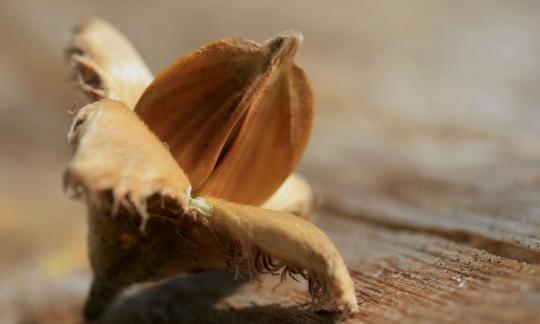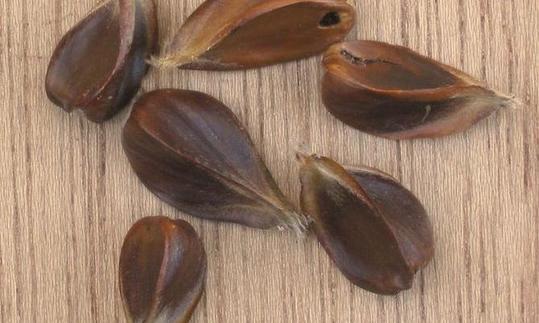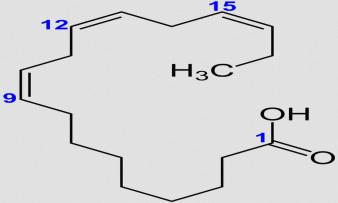Table of contents
Beechnuts (beech nuts) are the fruits of the European beech ( Fagus sylvatica ). The triangular nuts are eaten raw Slightly poisonous in its dried form, but harmless and versatile in autumn cooking ( organic ).
Use in the kitchen
Beechnuts have a mild, nutty aroma. These days they rarely find their way into our kitchens. Can you eat beechnuts raw? As they are slightly poisonous when raw, they should be heated before consumption. When dried, boiled or roasted, they are safe to eat and can be used in numerous dishes. They are interesting alternatives to pistachios ,pumpkin seeds , sunflower seeds or bread cubes (croutons). The triangular nuts can be used as a topping to enhance leaf salads and fruit salads, or eaten on their own as a delicious snack between meals.
Ground beechnut flour can be mixed with wheat flour or spelt flour and used for cakes, biscuits and bread. On its own, it is less suitable for baking because it does not contain gluten, similar to ground nuts. Roasted beechnuts can also be used as an intensely flavoured coffee substitute. Other popular beechnut recipes include pestos and nutty, vegan spreads. Beechnuts can also be used to make oil. The production of this oil is complex, as you need around seven kilograms of dried beechnuts per litre of oil; however, the oil can be stored for a very long time and can be used not only for cooking, but also for salad dressings.
Your own preparation
Sorting and cleaning the collected beechnuts is easiest in a bowl of water. The parts floating on the top are then easy to fish out and dispose of. Only nuts lying at the bottom are full beechnuts. Beechnuts are best peeled when they are still a little wet. If you are using several of the nut-like fruits, it is worth using a knife to peel them and first use the tip of the knife to cut off the shell and cut into the three side shells. Then pierce under the shell and peel it off. To use beechnuts safely, you must first neutralize the slightly poisonous fagin by heating them. This can be done by drying the beechnuts in the oven or dehydrator. Alternatively, you can pour boiling water over the nuts or roast them in a pan for a few minutes. After that, they are either edible on their own or ready for further processing.
Vegan recipe for beechnut spread
Ingredients (for 4 people): 20 g dried beechnuts, 1 bunch of fresh chives , 500 g vegan low-fat quark, 2 tbsp rapeseed oil (cold-pressed) , 1 pinch of salt , a littlepepper , 1 dash of apple cider vinegar , 1 dash of soy milk .
Preparation: Chop the dried beechnuts as finely as possible (if necessary, use a blender). Wash the chives thoroughly, chop finely and place in a bowl. Add the low-fat quark, rapeseed oil and finely chopped beechnuts and mix everything thoroughly. Add plant-based milk until the spread has the desired consistency. Finally, season the vegan spread with salt and pepper and refine with a little apple cider vinegar.
Vegan recipe for autumn salad with beechnuts
Ingredients (for 2 people): 50 g beechnuts, 400 g cooked, diced beetroot , 1 orange , 2 white chicory , 2 tbsp white wine vinegar , 2 tbsp rapeseed oil (cold pressed) , salt andpepper to taste.
Preparation: For the vinaigrette, mix white wine vinegar, rapeseed oil, salt and pepper in a small bowl. Peel the beechnuts and roast them in a pan without fat for about 3 minutes. Peel the orange and cut into cubes, finely chop the chicory. Mix both ingredients together with the beetroot cubes and the vinaigrette. Serve in two plates and sprinkle the roasted beechnuts on top.
Vegan recipes with beechnuts (dried) can be found under the note: " Recipes that have the most of this ingredient ".
| Not only vegans or vegetarians should read this: Vegans often eat unhealthily. Avoidable nutritional mistakes . |
Purchasing - Storage
Beechnuts can be found in the autumn, from September to October, mainly in the wild - wherever there are red beech trees. Where can you buy beechnut seeds? Large retailers such as Coop , Migros , Denner , Volg , Spar , Aldi , Lidl , Rewe , Edeka , Hofer , Billa or organic supermarkets such as Denn's Biomarkt and Alnatura do not usually stock beechnuts. They can sometimes be bought online, in health food stores or delicatessens. Since red beech trees are not grown for commercial purposes, this is also reflected in the price of the beechnuts available in stores.
The availability of beechnuts varies depending on the size of the store, catchment area, etc. You can find our recorded food prices for the DA-CH countries above under the ingredient image - and by clicking you can see their development at various suppliers.
Found in the wild
In autumn, especially after hot summers, the fruits of the European beech can be found in large numbers on the forest floor. European beeches ( Fagus sylvatica ) belong to the beech family (Fagaceae) and grow in Europe where the climate is predominantly damp and cool. They are one of the few deciduous trees that can reach an age of up to 300 years. 1 However, only trees that are older than 40 years bear fruit and only every five to seven years do they produce an abundant harvest. 2 Apart from their similar name, beechnuts are not related to buckwheat ( Fagopyrum esculentum) .
Storage tips
Beechnuts can be stored in a dry place for up to a year. Alternatively, you can freeze them and thaw them again when needed.
Ingredients - Nutritional values - Calories
Dried beechnuts are very nutritious and contain monounsaturated and polyunsaturated fatty acids as well as proteins, vitamins and minerals. Beechnut ingredients provide 576 kcal of energy per 100 g. A large part of this comes from the fat they contain, with 50 g, followed by 34 g carbohydrates and 6.2 g proteins. 3
Manganese is present in dried beech nuts at 1.3 mg/100g (67% of the daily requirement). This is a similar amount to roasted pistachios without salt (1.2 mg/100g). This essential trace element plays an important role in carbohydrate metabolism and connective tissue. Significantly more manganese can be found in hazelnuts (6.2 mg/100g) or pumpkin seeds (4.5 mg/100g). 3
The dried fruit of the red beech contains 113 µg/100g folic acid (57% of the daily requirement). This means it contains slightly more than roasted peanuts without salt (97 µg/100g). The water-soluble vitamin is essential for cell renewal and is particularly important BEFORE pregnancy for the healthy development of the embryo. Good plant sources of folic acid are green leafy vegetables (e.g. fresh spinach 194 µg/100g), pulses (e.g. red lentils, cooked 181 µg/100g) or brassica vegetables (e.g. kale, raw 141 µg/100g). 3
100 g of dried beechnuts contain 1017 mg of potassium (51% of the daily requirement). This means that they provide a similar amount of this mineral as dried goji berries (1104 mg/100g) or raw pistachios (1025 mg/100g). Herbs, seeds and nuts are particularly good sources of potassium (e.g. almonds, raw with 730 mg/100g). Pulses also contain a lot of potassium, but they release a large amount of it into the water when cooked. 3
The complete ingredients of beech nuts (dried), the coverage of the daily requirement and comparison values with other ingredients can be found in our nutrient tables. In the article Nutrients explained you will get a detailed insight into the topic.
Effects on health
Is eating beechnuts healthy? Beechnuts mainly contain B vitamins, minerals such as potassium, and are good sources of iron and zinc . With almost 600 kcal, the small nuts are very high in energy. 3 The high fat content consists mainly of unsaturated fatty acids 3 , which have been shown to have a positive effect on cardiovascular diseases. 4 In a large cohort study, replacing saturated fatty acids with unsaturated fats had a positive effect on reducing the risk of sudden cardiac death in women. 4
The rather unfavorable ratio of omega-6 fatty acids (LA) to omega-3 fatty acids (ALA) of 11:1 speaks against consuming too many dried beech nuts. 3 A maximum ratio of 5:1 (LA:ALA) is still considered desirable. The Federal Nutrition Commission ( EEK ) now recommends absolute intake amounts rather than a ratio. For example, one should consume polyunsaturated fatty acids in quantities of 2.5-9% (omega-6 fatty acids) or 0.5-2% (omega-3 fatty acids) of the daily energy requirement. This corresponds to a maximum of 20 g per 2000 kcal (omega-6 fatty acids) or 1-4.4 g per 2000 kcal (omega-3 fatty acids). 4 The Western diet is characterized by a high proportion of omega-6 and a low proportion of omega-3 fatty acids. 5 Excessive amounts of polyunsaturated omega-6 fatty acids and a very high omega-6/omega-3 ratio promote the development of numerous diseases, including cardiovascular diseases, cancer, and inflammatory and autoimmune diseases. However, the intake of omega-3 fatty acids can counteract these developments. 6 Beech nuts still provide valuable nutrients. If eaten regularly and in moderation, the higher proportion of omega-6 fatty acids is not a problem.
Dangers - Intolerances - Side effects
When raw, the fruits contain oxalic acid and fagin (trimethylamine), which can lead to symptoms of poisoning. Therefore, the angular nuts should always be heated before consumption. 7 Symptoms of poisoning such as nausea, stomach cramps or vomiting appear more quickly in children and older people than in healthy adults. Nevertheless, one should avoid eating raw fruits whenever possible. 8 The human body converts the oxalic acid contained in beech nuts into calcium oxalate. This is a component of kidney stones and can have harmful effects on people who are prone to kidney stones or have damaged kidneys. Oxalic acid also makes it difficult for iron to be absorbed in the intestines. People who suffer from iron deficiency anemia should therefore be cautious about eating foods with a high oxalic acid content. Rhubarb , wood sorrel, sorrel , chard , spinach , parsley , cocoa , chocolate and beetroot also contain higher amounts of oxalic acid. 9
Ecological footprint - animal welfare
The CO2 footprint of food depends on factors such as the cultivation method (conventional/organic), the country of origin and transport, as well as processing and packaging. 13 Since beechnuts are still a rarely used ingredient, even nuts that can be purchased from specialist retailers or beechnut oils derived from them come from seasonal wild collection. This means that neither artificial irrigation nor other interventions in the natural ecosystem are necessary. Although processing and packaging are required in this case, the ecological footprint tends to be low. However, despite extensive research, we were unable to find any precise values for this. Collecting and processing beechnuts yourself is definitely the most environmentally friendly option.
Animal welfare - species protection
Beechnuts are an important source of food and winter fodder for animals living in the forest, such as wild boar, deer, roe deer and squirrels. The latter are also responsible for spreading the seeds when they can no longer find the nuts buried in the ground. In addition, beechnuts are often part of bird feed for birds that do not spend the winter in more southerly regions. In contrast to us humans, animals are less sensitive to raw beechnuts. Dogs and horses are an exception, as they have a similar poor tolerance to raw nuts as we humans. 8
Worldwide occurrence - cultivation
Fagus sylvatica , the European beech (European beech), is a deciduous tree found in Europe. 10 Its current distribution is in Western and Central Europe and extends from the Iberian Peninsula, Sicily and the Balkans in the south, through France and Germany to southern England, southern Scandinavia and northeastern Poland in the north and the Carpathians in the east. In colder areas it is more likely to be found at lower altitudes, but in the south it is a typical mountain tree. It is the most common tree species in Central Europe. 11
Further information
During the Second World War, the civilian population often resorted to wild plants due to food shortages and famine. The wild species regularly consumed included nettles, blackberries and beechnuts. 12 In heraldry (the study of coats of arms and their use), it is depicted as a common figure together with beech leaves and often in an open fruit cup.
Alternative names
Beechnuts (singular: Buchecker) are also called "Buchel" in German-speaking countries. In Switzerland they are known as "Buchennüsschen". In English, beechnuts are called "beechnut". Incorrect spellings such as "Buchekern" can occur.
Other uses
The shells of beechnuts are ideal for crafting and decorating. In combination with autumn leaves, rose hips or other nuts, for example, the outward-curved wings of the fruit cups can be used to create door wreaths and other autumn or winter table decorations. 8










Comments